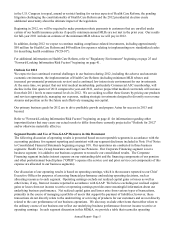Aetna 2011 Annual Report Download - page 20
Download and view the complete annual report
Please find page 20 of the 2011 Aetna annual report below. You can navigate through the pages in the report by either clicking on the pages listed below, or by using the keyword search tool below to find specific information within the annual report.Annual Report- Page 14
Net Realized Capital Gains and Losses
Net realized capital gains were $168 million in 2011, $228 million in 2010 and $55 million in 2009. The net
realized capital gains in 2011, 2010 and 2009 primarily reflect sales of debt securities. In 2011 and 2010, these
gains were partially offset by losses on derivative transactions while in 2009, these gains were also attributable to
gains on derivative transactions partially offset by OTTI losses.
Yield-related OTTI losses were not significant in 2011 or 2010. In 2009, yield-related OTTI losses were $76
million, primarily related to U.S. Treasury and corporate securities that were temporarily in a loss position due to
changes in interest rates and the widening of credit spreads on corporate securities relative to the interest rates on
U.S. Treasury securities in the first half of 2009. Because we did not assert our intention to hold these securities,
under applicable accounting guidance, we recorded a yield-related OTTI loss. We had no other individually
material realized capital losses on debt or equity securities that impacted our operating results in 2011, 2010 or
2009.
Mortgage Loans
Our mortgage loan portfolio (which is collateralized by commercial real estate) represented 8% of our total invested
assets at both December 31, 2011 and 2010. There were no material impairment reserves on these loans at
December 31, 2011 or 2010. Refer to Note 8 of Notes to Consolidated Financial Statements on page 78 for
additional information on our mortgage loan portfolio.
Risk Management and Market-Sensitive Instruments
We manage interest rate risk by seeking to maintain a tight match between the durations of our assets and liabilities
where appropriate. We manage credit risk by seeking to maintain high average quality ratings and diversified sector
exposure within our debt securities portfolio. In connection with our investment and risk management objectives,
we also use derivative financial instruments whose market value is at least partially determined by, among other
things, levels of or changes in interest rates (short-term or long-term), duration, prepayment rates, equity markets or
credit ratings/spreads. Our use of these derivatives is generally limited to hedging risk and has principally consisted
of using interest rate swap agreements, forward contracts, futures contracts, put options and credit default
swaps. Additionally, from time to time, we receive warrants from our vendors. These instruments, viewed
separately, subject us to varying degrees of interest rate, equity price and credit risk. However, when used for
hedging, we expect these instruments to reduce overall risk.
We regularly evaluate our risk from market-sensitive instruments by examining, among other things, levels of or
changes in interest rates (short-term or long-term), duration, prepayment rates, equity markets or credit ratings/
spreads. We also regularly evaluate the appropriateness of investments relative to our management-approved
investment guidelines (and operate within those guidelines) and the business objectives of our portfolios.
On a quarterly basis, we review the impact of hypothetical net losses in our investment portfolio on our
consolidated near-term financial position, operating results and cash flows assuming the occurrence of certain
reasonably possible changes in near-term market rates and prices. Interest rate changes represent the most material
risk exposure category for us. We determine the potential effect of interest rate risk on near-term net income, cash
flow and fair value based on commonly-used models. The models project the impact of interest rate changes on a
wide range of factors, including duration, put options and call options. We also estimate the impact on fair value
based on the net present value of cash flows using a representative set of likely future interest rate scenarios. The
assumptions used were as follows: an immediate increase of 100 basis points in interest rates (which we believe
represents a moderately adverse scenario and is approximately equal to the historical annual volatility of interest
rate movements for our intermediate-term available-for-sale debt securities) and an immediate decrease of 25% in
prices for domestic equity securities.
























